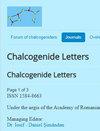退火对化学喷雾热解法制备SnS薄膜光电流响应的影响
IF 1.2
4区 材料科学
Q4 MATERIALS SCIENCE, MULTIDISCIPLINARY
引用次数: 0
摘要
采用喷雾热解法制备SnS薄膜,分别在350、400、450℃下退火。晶体学分析表明,制备的SnS薄膜为多晶正交晶系。在350°C、400°C和450°C退火后,晶粒尺寸分别为47、66和37 nm。SEM和AFM图像显示,样品表面被完全覆盖。因此,SnS纳米结构的晶粒具有颗粒状形状,并随退火温度的变化而变化。透射率测试表明,在400℃下退火使样品的吸收范围延长并提高到600 nm。在350°C、400°C和450°C下退火得到的能带能分别为1.60 eV、1.30 eV和2.55 eV。霍尔效应测量表明,在400℃下退火SnS薄膜可以提高其电学性能。载流子迁移率、电导率和载流子浓度分别为1.678 ×105 Cm2/Vs、9.756 ×10-5 Ω-1 cm-1和3.168 ×1010Cm-3。此外,光电流响应验证了在350、400和450°C退火的所有样品具有p型电导率,分别为13、28和2.5µA/Cm2。在400℃的退火条件下,获得了最佳的电导率、载流子迁移率和光电流值。因此,SnS薄膜可以成为光伏系统中吸收层应用的有趣选择。本文章由计算机程序翻译,如有差异,请以英文原文为准。
Annealing effect on the photocurrent response of SnS thin films prepared by the chemical spray pyrolysis method
SnS thin films were synthesized using the spray pyrolysis method and then annealed at 350, 400, and 450°C. According to the crystallographic analysis, the obtained SnS thin films crystallized in the polycrystalline orthorhombic system. The grains measured 47, 66, and 37 nm for the samples annealed at 350, 400, and 450°C, respectively. SEM and AFM images indicate that the samples’ surfaces were completely covered. Thus, the grains of SnS nanostructures have a granular-like shape and vary in size depending on the annealing temperatures. The transmittance measurement shows that annealing the sample at 400 °C extends and improves its absorption range to 600 nm. The resulting band gap energies were 1.60 eV, 1.30 eV, and 2.55 eV for annealing at 350 °C, 400 °C, and 450 °C, respectively. Hall Effect measurements reveal that annealing SnS films at 400 °C enhances their electrical properties. The values of carrier mobility, conductivity, and carrier concentration are 1.678 ×105 Cm2/Vs, 9.756 ×10-5 Ω-1 cm-1 , and 3.168 ×1010Cm-3 , respectively. Additionally, the photocurrent response validates that all samples annealed at 350, 400, and 450 °C have p-type conductivity, with values of 13, 28, and 2.5 µA/Cm2, respectively. The best conductivity, carrier mobility, and photocurrent values are obtained by annealing at 400 °C. Therefore, SnS thin films can be an interesting choice for absorber layer applications in photovoltaic systems.
求助全文
通过发布文献求助,成功后即可免费获取论文全文。
去求助
来源期刊

Chalcogenide Letters
MATERIALS SCIENCE, MULTIDISCIPLINARY-PHYSICS, APPLIED
CiteScore
1.80
自引率
20.00%
发文量
86
审稿时长
1 months
期刊介绍:
Chalcogenide Letters (CHL) has the aim to publish rapidly papers in chalcogenide field of research and
appears with twelve issues per year. The journal is open to letters, short communications and breakings news
inserted as Short Notes, in the field of chalcogenide materials either amorphous or crystalline. Short papers in
structure, properties and applications, as well as those covering special properties in nano-structured
chalcogenides are admitted.
 求助内容:
求助内容: 应助结果提醒方式:
应助结果提醒方式:


